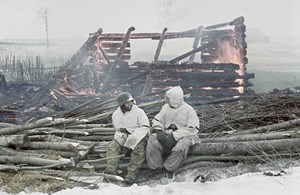
Photographs play a central role in the memory of World War II. As a supposedly objective source, they were and are reproduced in books, films, documentaries and exhibitions and continue to shape visual memory to this day. This also applies to the war against the Soviet Union, in which the Germans committed unprecedented crimes against prisoners of war and the civilian population after the invasion on June 22, 1941.
Albert Dieckmann (1896-1982) was a passionate amateur photographer who discovered color photography early on. At the beginning of July 1941, the doctor, husband and father of three children was transferred as a staff officer to the Soviet territories that had been conquered by the Wehrmacht shortly before. Until his return to the German Reich in the summer of 1942, he took many photographs in Belarus, Russia and Poland. Since 2007, more than 380 color slides by Albert Dieckmann have been in the collection of the Museum Berlin-Karlshorst.
The current exhibition shows 40 of these color photos. In contrast to usual photo exhibitions, it contextualizes the images comprehensively. For this purpose, archival research was used to reconstruct the deployment of the Radfahr-Wachbataillon 48 (B), in whose staff Albert Dieckmann served as a doctor. This unit was subordinate to various commanders of the rear army area since July 1941. These so-called Korücks administered the occupied areas between the battle area and the rear army areas. Their task was to secure supply routes, supply bases, railroad lines, and communications links, as well as to guard and remove prisoners of war. The units subordinated to the Korücks were involved in various crimes against prisoners of war and against the (Jewish and non-Jewish) civilian population, including the Radfahr-Wachbataillon 48 (B).
In addition to the color photos, the exhibition presents exemplary quotations from archival documents as well as quotations from letters written by Albert Dieckmann to his wife during his deployment. An independent level of the exhibition is formed by the source-critical approach to the pictures shown. Why did Albert Dieckmann choose these motifs? What did he photograph and what is missing from his photographs? Can conclusions be drawn from his pictures about his attitude, e.g. towards the local population? How did those photographed react? How do we look at the pictures? And how does our view change when we know more about the context? These and other questions will encourage visitors to engage with the images in a source-critical way.
Graphic novel elements link the compilation of photos, document and letter quotations, guiding questions and exhibition texts. They support the deconstruction of the pictorial content and open up a new level for mediation. In this way, a pictorial story is created on 30 exhibition panels that makes the exhibition content accessible to a broad audience in an innovative way.

ArtDependence Magazine is an international magazine covering all spheres of contemporary art, as well as modern and classical art.
ArtDependence features the latest art news, highlighting interviews with today’s most influential artists, galleries, curators, collectors, fair directors and individuals at the axis of the arts.
The magazine also covers series of articles and reviews on critical art events, new publications and other foremost happenings in the art world.
If you would like to submit events or editorial content to ArtDependence Magazine, please feel free to reach the magazine via the contact page.